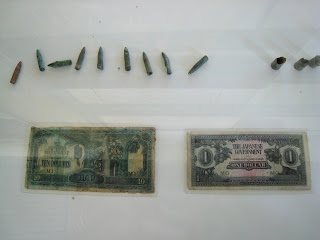
Picture in the Kundasang Memorial Hall - by artist, Non Meston in honour of her father, Alwyn CADWGAN who died on the Second March, 2 June 1945. Aged 43
The Sandakan to Ranau Death Marches made deep imprints in my husband's mind. He caught it by accident on the History Channel, ASTRO. Then, we had planned a trip to Kota Kinabalu ( formerly Jesselton). The story which unfolded moved him and he was determined to visit the memorial in honour of POWs who perished under the Japanese during WW2.
We stayed at Kinabalu Park during our recent holiday. Kundasang War Memorial, at the foothills of Mount Kinabalu was on our 'to visit' list. The taxi man took us there. A short ride away from the bustling colourful vegetable markets of Kundasang. In the Hall, with some Australian families, we watched an ANZAC Day video presentation of the story of the Sandakan Death Marches.
A silent audience watched and listened to the tragic episode of the war. Hearts weep for these brave men, some in their teens, mostly in their twenties who suffered severe atrocities by the Japanese army. Humanity must never walk down this road again.

The POWs in Sandakan were members of the Allied contingent transferred to Sandakan by the Japanese in 1942 -43 following Singapore's fall. They were forced to build an airstrip with not much more than their bare hands.
In mid 1943, the Japanese discovered that the POWs not only had a radio but were in league with a local resistance organisation. Discipline became hardened for the remaining 2428 prisoners.
As the war raged on and with the Allies getting closer, the Japanese decided to move large groups of prisoners at Sandakan. In Jan 1945 the first of the three forced 'Death Marches' began. The Japanese army decided to move 455 of the fittest prisoners to Jesselton (renamed Kota Kinabalu). The POWs were used as mule trains - carrying baggage, heavy ammunition, rice and other stuff on their backs for the Japanese battalions relocating to the western coast. Owing to Allied air and sea activity on the west coast of Borneo, the POWs were halted at Ranau, a small village on the flanks of Mount Kinablau. Then followed the 2nd march (570 servicemen )and 3rd march (537 servicemen ) to Ranau.
The POWs had to trek through swamps, dense, inhospitable jungles and mountain terrains. A trek of 265 km through rugged jungle of Borneo . Little or no medical aid was given. The POWs were malnourished or suffered from illnesses. On starvation rations, the prisoners were forced to forage for food. Those who were too ill to do any work were shot by the Japanese guards.
Bombardier Richard 'Dick' Braithwaithe, one of the survivors on the 2nd March who was helped by the locals in his escape recalls, 'It was a one -way trip when we started to hear shots and you felt there was no hope for anyone who fell out.' The ones who could not keep up were 'disposed of'' or left to die en route.
Private Keith Botterill, 2/19th Battalion recalls: 'No effort whatsoever was made to bury the men. They would just pull them 5-15 yards off the track and bayonet them or shoot them, depending on the condition of the men. If they were conscious and it was what we thought was a good kind guard, they'd shoot them. There was nothing we could do.'
In captivity for 3 long years and living in the harshest of conditions and under brutal treatment by the Japanese, these servicemen were walking skeletons, unrecognisable as human.
Back at Sandakan, 200 prisoners unable to undertake the death march also died - killed or suffered diseases like dysentery and many tropical ailments.
2428 prisoners were incarcerated at Sandakan. 1787 were Australian. The remaining were British. Only 6 survived because they escaped - all Australian.
The story of Sandakan and the death marches is one of the most tragic yet heroic. These POWs showed indomitable determination and spirit to live.
A War Memorial and Gardens of Rememberance was built at Kundasang, Sabah in 1962 to commemorate those who died at Sandakan and Ranau. The memorial also remembers the people of North Borneo who risked their lives to help the POWs.



Outside the Hall, under a shelter crammed with memorabilia - visitors get glimpses of the tragic story of the POWS


Australia honours her dead
4 interlocking gardens to represent homelands - Australian, English, Borneo and the Contemplation Garden and Pool.

Borneo Garden - beautiful orchids and plants of Borneo

From the balcony of the Memorial looking down on Kundasang
Lest we forget

Domima OKK Akoi, from Kg Paginata, Ranau helped the POWs. At age 12/13 years, she left food for the POWs at the same spot. For 6 days, food was eaten. On the 7th day, the food was untouched. She heard gunfire and the soldiers never appeared again.
Amazing find : 6 gold rings in a tobacco tin at the same spot as a token of gratitude. She still keeps one; the rest were given away after the war.

265 km slow walk through HELL!
( picture credit: Lynette Silver, author, military researcher and tour guide)



































.png)
.png)














